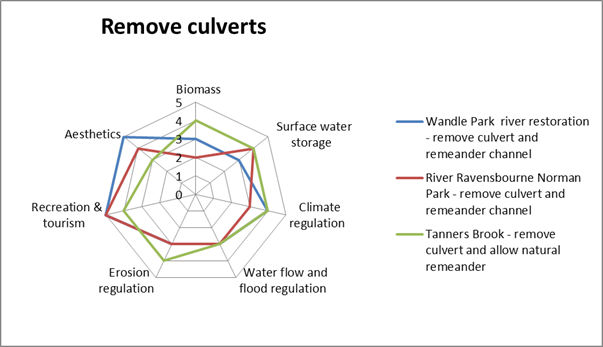This activity involves techniques to resolve the issues created by culverted watercourses. This is predominantly through deculverting, or ‘daylighting’ which involves opening up buried watercourses and restoring the bed, bank and riparian corridor to more natural conditions.
 Opportunities to deculvert should be explored as much as possible as a flood and coastal risk management activity, under consents that are issued via the Environment Agency, and the requirements for planning applications.
Opportunities to deculvert should be explored as much as possible as a flood and coastal risk management activity, under consents that are issued via the Environment Agency, and the requirements for planning applications.
In some cases, 'daylighting' may not involve removing the whole culverted structure but could involve just removing the top. This has fewer benefits, but is still a significant improvement.
Techniques
There are a limited number of techniques that can be used to implement this environmental improvement, depending upon the location and constraints in and around the culvert. These include:
- Completely remove the culvert and bank reprofiling to renaturalise the watercourse
- Remove the ‘lid’ of the culvert
- Create gaps in the culvert top to provide daylight into the watercourse
Benefits
Re-opening existing culverts can deliver a wide range of direct and indirect benefits, including:
- Direct benefits to salmonids, eels, coarse fish and other aquatic organisms by encouraging free movement of populations and individuals within the water body due to increase light
- Direct benefits to plants, invertebrates, birds and animals which can now live on the banks and riparian zone
- Improvements to in-channel habitats for aquatic plants, fish and invertebrates due to exposure to light
- Improvements to the physical habitat conditions of the watercourse, including the creation of a more natural bank profile and the creation of more varied habitat niches
- Restoration of natural processes, including erosion and deposition
- Improvements to the aesthetic value of the watercourse and improvements to its recreational value
- Reduction in maintenance costs of hard defences
- Reduction in health and safety risk
Case Study Benefits
This diagram displays a comparison of benefits scores (using a high-level ecosystem service assessment methodology) associated with the techniques used in each case study. More details on the methodology can be found here.